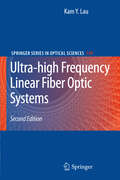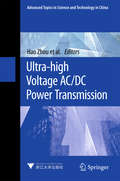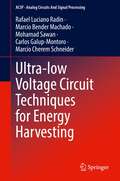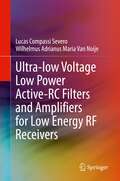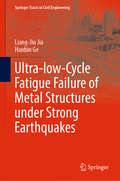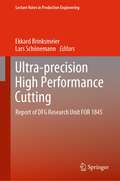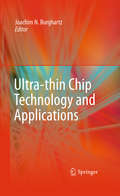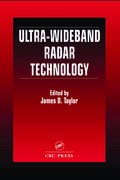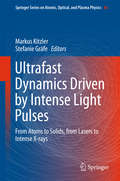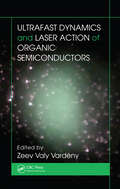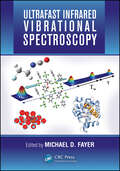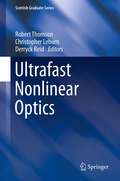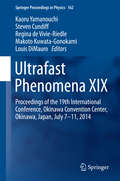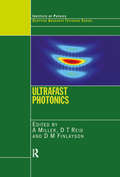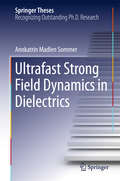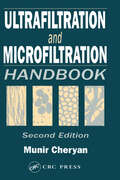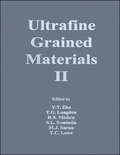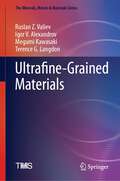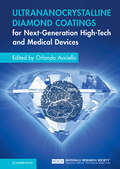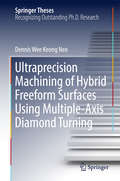- Table View
- List View
Ultra-dense Networks: Principles and Applications
by Tony Q. S. Quek Haijun Zhang Chih-Lin I Jemin LeeUnderstand the theoretical principles, key technologies and applications of UDNs with this authoritative survey. Theory is explained in a clear, step-by-step manner, and recent advances and open research challenges in UDN physical layer design, resource allocation and network management are described, with examples, in the context of B5G and 6G standardization. Topics covered include NOMA-based physical layer design, physical layer security. Interference management, 3D base station deployment, software defined UDNs, wireless edge caching in UDNs, UDN-based UAVs and field trials and tests. A perfect resource for graduate students, researchers and professionals who need to get up to speed on the state of the art and future opportunities in UDNs.
Ultra-high Frequency Linear Fiber Optic Systems
by Kam Y. LauThis book provides an in-depth treatment of both linear fiber-optic systems and their key enabling devices. It presents a concise but rigorous treatment of the theory and practice of analog (linear) fiber-optics links and systems that constitute the foundation of Hybrid Fiber Coax infrastructure in present-day CATV distribution and cable modem Internet access. Emerging applications in remote fiber-optic feed for free-space millimeter wave enterprise campus networks are also described. Issues such as dispersion and interferometric noise are treated quantitatively, and means for mitigating them are explained. This broad but concise text will thus be invaluable not only to students of fiber-optics communication but also to practicing engineers. To the second edition of this book important new aspects of linear fiber-optic transmission technologies are added, such as high level system architectural issues, algorithms for deriving the optimal frequency assignment, directly modulated or externally modulated laser transmitters and the use of Erbium-doped fiber amplifier (EDFA) in linear fiber optic systems. Significant examples of field deployed military systems enabled by linear fiber optic links are described in an appendix.
Ultra-high Voltage AC/DC Power Transmission
by Hao Zhou Wenqian Qiu Ke Sun Jiamiao Chen Xu Deng Feng Qian Dongju Wang Bincai Zhao Jiyuan Li Sha Li Yuting Qiu Jingzhe YuThis book addresses the latest findings on practical ultra-high voltage AC/DC (UHVAC/UHVDC) power transmission. Firstly, it reviews current constructions and future plans for major UHVDC and UHVAC projects around the world. The book subsequently illustrates the basic theories, economic analysis, and key technologies of UHV power networks in detail, and describes the design of the UHVAC substations and UHVDC converter stations and transmission lines. A wealth of clear and specific figures and formulas help readers to understand the fundamental theories underlying UHVAC and UHVDC technologies, as well as their developmental trends. This book is intended for graduate students, researchers and engineers in the fields of power systems and electrical engineering.
Ultra-low Voltage Circuit Techniques for Energy Harvesting (Analog Circuits and Signal Processing)
by Carlos Galup-Montoro Mohamad Sawan Rafael Luciano Radin Marcio Bender Machado Marcio Cherem SchneiderThis book provides design-oriented models for the implementation of ultra-low-voltage energy harvesting converters, covering the modeling of building blocks such oscillators, rectifiers, charge pumps and inductor-based converters that can operate with very low supply voltages, typically under 100 mV. Analyses based on the diode and MOSFET models are included in the text to allow the operation of energy harvesters from voltages of the order of 100 mV or much less, with satisfactory power efficiency. The practical realization of different converters is also addressed, clarifying the design trade-offs of ultra-low voltage (ULV) circuits operating from few millivolts.Offers readers a state-of-the-art revision for ultra-low voltage (ULV) energy harvesting converters;Provides analog IC designers with proper models for the implementation of circuits and building blocks of energy harvesters, such as oscillators, rectifiers, and inductor-based converters, operating under ultra-low voltages;Addresses the design of energy harvesters operating from ultra-low voltages, enabling autonomous operation of connected devices driven by human energy;Demonstrates design and implementation of integrated ULV up-converters;Includes semiconductor modeling for ULV operation.
Ultra-low Voltage Low Power Active-RC Filters and Amplifiers for Low Energy RF Receivers
by Lucas Compassi Severo Wilhelmus Adrianus Van NoijeThis book presents innovative strategies to implement ultra-low voltage (ULV) and low power active circuits used in low energy RF receivers. The authors demonstrate that the use of single-stage amplifiers with the input negative transconductance compensation is a key strategy to allow the operation at low voltage levels with reduced power dissipation. Also, some design methodologies, based on the CMOS transistor operation point, are analyzed and a powerful design methodology is described for this kind of circuit. Readers will be enabled to implement the techniques described to design communication circuits with low power dissipation, useful in a variety of applications, including IoT/IoE devices.
Ultra-low-Cycle Fatigue Failure of Metal Structures under Strong Earthquakes (Springer Tracts in Civil Engineering)
by Liang-Jiu Jia Hanbin GeThis book presents experimental results and theoretical advances in the field of ultra-low-cycle fatigue failure of metal structures under strong earthquakes, where the dominant failure mechanism is ductile fracture. Studies on ultra-low-cycle fatigue failure of metal materials and structures have caught the interest of engineers and researchers from various disciplines, such as material, civil and mechanical engineering. Pursuing a holistic approach, the book establishes a fundamental framework for this topic, while also highlighting the importance of theoretical analysis and experimental results in the fracture evaluation of metal structures under seismic loading. Accordingly, it offers a valuable resource for undergraduate and graduate students interested in ultra-low-cycle fatigue, researchers investigating steel and aluminum structures, and structural engineers working on applications related to cyclic large plastic loading conditions.
Ultra-precision High Performance Cutting: Report of DFG Research Unit FOR 1845 (Lecture Notes in Production Engineering)
by Ekkard Brinksmeier Lars SchönemannThis book contains the research report of the DFG Research Unit FOR 1845 (2014-2020) of the Universities of Bremen and Hannover. The thematic focus lies on speeding up ultra-precision machining technology by following a holistic approach to high-performance cutting. This includes ultra-precision milling at high spindle speeds (>10000 rpm), precision tool setting mechanisms for multi-cutting-edge diamond milling tools, magnetic levitation technology for high velocity feed axes, and dedicated control strategies for error identification and compensation at high speeds. Furthermore, automation and measurement aspects of the machine setup process especially for precision balancing of the spindle rotors are presented. Finally, it is demonstrated that how the developed technologies may be integrated into a common machine tool setup. The target audience primarily comprises research experts and practitioners in production engineering, but the book may also be of interest to graduate students alike.
Ultra-thin Chip Technology and Applications
by Joachim BurghartzUltra-thin chips are the "smart skin" of a conventional silicon chip. This book shows how very thin and flexible chips can be fabricated and used in many new applications in microelectronics, Microsystems, biomedical and other fields. It provides a comprehensive reference to the fabrication technology, post processing, characterization and the applications of ultra-thin chips.
Ultra-wideband Radar Technology
by James D. TaylorIn 1995, James D. Taylor's Introduction to Ultra-Wideband Radar Systems introduced engineers to the theory behind a promising new concept for remote sensing. Since then, the field has undergone enormous growth with new applications realized and more applications conceptualized at a remarkable pace. However, understanding ultra-wideband (UWB) radar requires a new philosophical approach. Concepts such as radar cross section will have new meanings as range resolution becomes smaller than the target.Ultra-Wideband Radar Technology is a guide to the future of radar by an international team of experts. They present the problems, solutions, and examples of UWB radar remote sensing. Chapters discuss the theory and ideas for future systems development, and show the potential capabilities. The writers present concepts such as the differences between UWB and conventional radars, improving over-resolved target detection, receivers and waveforms, micropower systems, high power switching, and bistatic radar polarimetry.Finding comparable information elsewhere might require consulting hundreds of other books, technical journals, and symposium proceedings. Ultra-Wideband Radar Technology offers a unique opportunity to explore the theory, applications, and technology of UWB radar within a single source.
Ultrafast Dynamics Driven by Intense Light Pulses
by Markus Kitzler Stefanie GräfeThis book documents the recent vivid developments in the research field of ultrashort intense light pulses for probing and controlling ultrafast dynamics. The recent fascinating results in studying and controlling ultrafast dynamics in ever more complicated systems such as (bio-)molecules and structures of meso- to macroscopic sizes on ever shorter time-scales are presented. The book is written by some of the most eminent experimental and theoretical experts in the field. It covers the new groundbreaking research directions that were opened by the availability of new light sources such as fully controlled intense laser fields with durations down to a single oscillation cycle, short-wavelength laser-driven attosecond pulses and intense X-ray pulses from the upcoming free electron lasers. These light sources allowed the investigation of dynamics in atoms, molecules, clusters, on surfaces and very recently also in nanostructures and solids in new regimes of parameters which, in turn, led to the identification of completely new dynamics and methods for controlling it. Example topics covered by this book include the study of ultrafast processes in large molecules using attosecond pulses, control of ultrafast electron dynamics in solids with shaped femtosecond laser pulses, light-driven ultrafast plasmonic processes on surfaces and in nanostructures as well as research on atomic and molecular systems under intense X-ray radiation. This book is equally helpful for people who would like to step into this field (e. g. young researchers), for whom it provides a broad introduction, as well as for already experienced researchers who may enjoy the exhaustive discussion that covers the research on essentially all currently studied objects and with all available ultrafast pulse sources.
Ultrafast Dynamics and Laser Action of Organic Semiconductors
by Zeev Valy VardenySpurred on by extensive research in recent years, organic semiconductors are now used in an array of areas, such as organic light emitting diodes (OLEDs), photovoltaics, and other optoelectronics. In all of these novel applications, the photoexcitations in organic semiconductors play a vital role. Exploring the early stages of photoexcitations that
Ultrafast Infrared Vibrational Spectroscopy
by Michael D. FayerThe advent of laser-based sources of ultrafast infrared pulses has extended the study of very fast molecular dynamics to the observation of processes manifested through their effects on the vibrations of molecules. In addition, non-linear infrared spectroscopic techniques make it possible to examine intra- and intermolecular interactions and how su
Ultrafast Laser Nanostructuring: The Pursuit of Extreme Scales (Springer Series in Optical Sciences #239)
by Razvan Stoian Jörn BonseBringing together contributions from leading experts in the field, this book reviews laser processing concepts that allow the structuring of material beyond optical limits, and methods that facilitate direct observation of the underlying mechanisms by exploring direct structuring and self-organization phenomena. The capacity to nanostructure material using ultrafast lasers lays the groundwork for the next generation of flexible and precise material processing tools. Rapid access to scales of 100 nm and below in two and three dimensions becomes a factor of paramount importance to engineer materials and to design innovative functions. To reflect the dynamic nature of the field at all levels from basic science to applications, the book is divided into three parts, Fundamental Processes, Concepts of Extreme Nanostructuring, and Applications, each of which is comprehensively covered. This book will be a useful resource for graduate students and researchers in laser processing, materials engineering, and nanoscience.
Ultrafast Lasers: A Comprehensive Introduction to Fundamental Principles with Practical Applications (Graduate Texts in Physics)
by Ursula KellerThis textbook presents a comprehensive introduction to ultrafast laser physics with a keen awareness of the needs of graduate students. It is self-contained and ready to use for both ultrafast laser courses and background for experimental investigation in the lab. The book starts with an advanced introduction to linear and nonlinear pulse propagation, details Q-switching and modelocking and goes into detail while explaining ultrashort pulse generation and measurement. Finally, the characterization of the laser signals is illustrated, and a broad range of applications presented. A multitude of worked examples and problems with solutions help to deepen the reader's understanding.
Ultrafast Lasers: Technology and Applications
by Martin E. Fermann Almantas Galvanauskas Gregg SuchaCovering high-energy ultrafast amplifiers and solid-state, fiber, and diode lasers, this reference examines recent developments in high-speed laser technology. It presents a comprehensive survey of ultrafast laser technology, its applications, and future trends in various scientific and industrial areas. Topics include: micromachining applications
Ultrafast Nonlinear Optics
by Robert Thomson Christopher Leburn Derryck ReidThe field of ultrafast nonlinear optics is broad and multidisciplinary, and encompasses areas concerned with both the generation and measurement of ultrashort pulses of light, as well as those concerned with the applications of such pulses. Ultrashort pulses are extreme events - both in terms of their durations, and also the high peak powers which their short durations can facilitate. These extreme properties make them powerful experiment tools. On one hand, their ultrashort durations facilitate the probing and manipulation of matter on incredibly short timescales. On the other, their ultrashort durations can facilitate high peak powers which can drive highly nonlinear light-matter interaction processes. Ultrafast Nonlinear Optics covers a complete range of topics, both applied and fundamental in nature, within the area of ultrafast nonlinear optics. Chapters 1 to 4 are concerned with the generation and measurement of ultrashort pulses. Chapters 5 to 7 are concerned with fundamental applications of ultrashort pulses in metrology and quantum control. Chapters 8 and 9 are concerned with ultrafast nonlinear optics in optical fibres. Chapters 10 to 13 are concerned with the applications of ultrashort pulses in areas such as particle acceleration, microscopy, and micromachining. The chapters are aimed at graduate-student level and are intended to provide the student with an accessible, self-contained and comprehensive gateway into each subject.
Ultrafast Phenomena XIX
by Kaoru Yamanouchi Steven Cundiff Regina Vivie-Riedle Makoto Kuwata-Gonokami Louis DimauroThis book presents the latest advances in ultrafast science, including both ultrafast optical technology and the study of ultrafast phenomena. It covers picosecond, femtosecond, and attosecond processes relevant to applications in physics, chemistry, biology, and engineering. Ultrafast technology has a profound impact in a wide range of applications, amongst them biomedical imaging, chemical dynamics, frequency standards, material processing, and ultrahigh-speed communications. This book summarizes the results presented at the 19th International Conference on Ultrafast Phenomena and provides an up-to-date view of this important and rapidly advancing field.
Ultrafast Photonics (Scottish Graduate Series)
by A. Miller D. T. Reid D. M. FinlaysonUltrafast photonics has become an interdisciplinary topic of high international research interest because of the spectacular development of compact and efficient lasers producing optical pulses with durations in the femtosecond time domain. Present day long-haul telecommunications systems are almost entirely based on the transmission of short burst
Ultrafast Strong Field Dynamics in Dielectrics
by Annkatrin Madlen SommerThis thesis presents a systematic discussion of experimental approaches to investigating the nonlinear interaction of ultrashort visible strong fields with dielectrics directly in the time domain. The key finding is the distinctly different peak-intensity dependence of the light-matter energy transfer dynamics on the one hand, and the observed transient optical and electronic modifications on the other. As the induced electron dynamics evolve on sub-femtosecond timescales, real-time spectroscopy requires attosecond temporal resolution. This allows a range of parameters to be identified where the optical properties of the samples exposed to ultrashort light fields suffer dramatic changes allowing signal metrology while real absorption leading to dissipation is essentially absent. These findings indicate the feasibility of efficient optical switching at frequencies several orders of magnitude faster than current state-of-the-art electronics and thus have far-reaching technological consequences.
Ultrafast Supercontinuum Generation in Transparent Solid-State Media (SpringerBriefs in Physics)
by Audrius Dubietis Arnaud CouaironThis book presents the underlying physical picture and an overview of the state of the art of femtosecond supercontinuum generation in various transparent solid-state media, ranging from wide-bandgap dielectrics to semiconductor materials, and across various parts of the optical spectrum, from the ultraviolet to the mid-infrared. A particular emphasis is placed on the most recent experimental developments: multioctave supercontinuum generation with pumping in the mid-infrared spectral range, spectral control, power and energy scaling of broadband radiation and the development of simple, flexible and robust pulse compression techniques, which deliver few optical cycle pulses and which could be readily implemented in a variety of modern ultrafast laser systems. The expected audience includes graduate students, professionals and scientists working in the field of laser-matter interactions and ultrafast nonlinear optics.
Ultrafiltration and Microfiltration Handbook
by Munir CheryanSoon after its publication in 1987, the first edition of Ultrafiltration Handbook became recognized as the leading handbook on ultrafiltration technology. Reviews in professional journals praised it as an authoritative and substantive information resource on this technology. Now a completely, updated and expanded edition is available under the titl
Ultrafine Grained Materials II
by Terence G. Langdon Terry C. Lowe Yuntian Theodore Zhu Rajiv S. Mishra S. Lee Semiatin M. SaranProceedings of a symposium sponsored by the Shaping and Forming Committee of the Materials Processing and Manufacturing Division (MPMD) and the Mechanical Behavior Committee (Jt. SMD/ASM-MSCTS) of the Structural Materials Division (SMD) of TMS (The Minerals, Metals & Materials Society) and held during the 2002 TMS Annual Meeting in Seattle, Washington February 17-21,2002.
Ultrafine-Grained Materials (The Minerals, Metals & Materials Series)
by Terence G. Langdon Ruslan Z. Valiev Megumi Kawasaki Igor V. AlexandrovThis book summarizes and provides a detailed overview of the enhanced mechanical and functional properties of bulk nanostructured metallic materials with respect to their potential applications. These applications include nanostructured Ti-based materials in bio-medical engineering, Al alloys and Cu in electrical engineering and nanostructured steels in construction engineering. Moreover, this book describes the application of severe plastic deformation for the formation of hybrid metal systems from simple powders and solid metals for an enhancement in the functional properties of materials. Authored by global leaders in the field, this book will serve as a bridge between researchers and professionals engineering the newest nanomaterials.
Ultrananocrystalline Diamond Coatings for Next-Generation High-Tech and Medical Devices
by Orlando AucielloA comprehensive guide to the science of a transformational ultrananocrystalline-diamond (UNCDTM) thin film technology enabling a new generation of high-tech and external and implantable medical devices. Edited and co-authored by a co-originator and pioneer in the field, it describes the synthesis and material properties of UNCDTM coatings and multifunctional oxide/nitride thin films and nanoparticles, and how these technologies can be integrated into the development of implantable and external medical devices and treatments of human biological conditions. Bringing together contributions from experts around the world, it covers a range of clinical applications, including ocular implants, glaucoma treatment devices, implantable prostheses, scaffolds for stem cell growth and differentiation, Li-ion batteries for defibrillators and pacemakers, and drug delivery and sensor devices. Technology transfer and regulatory issues are also covered. This is essential reading for researchers, engineers and practitioners in the field of high-tech and medical device technologies across materials science and biomedical engineering.
Ultraprecision Machining of Hybrid Freeform Surfaces Using Multiple-Axis Diamond Turning
by Dennis Wee NeoThis thesis focuses on producing hybrid freeform surfaces using an advanced diamond-turning process, understanding the generation of surface accuracies (form errors) and how the choice of cutting strategies affects these, as well as simplifying the complications of generating cutting paths for such freeform surfaces. The breakthroughs behind this thesis are the development of novel, multiple-axis, diamond turning techniques to overcome the limitations of conventional diamond turning processes, an analytical model to optimize the generation of ultraprecise freeform surfaces, and an add-on tool path processor for CAD/CAM software solutions. It appeals to researchers and scholars with a strong machining background who are interested in the field of manufacturing ultraprecise freeform surfaces or in the field of optimizing ultraprecision machining processes.

